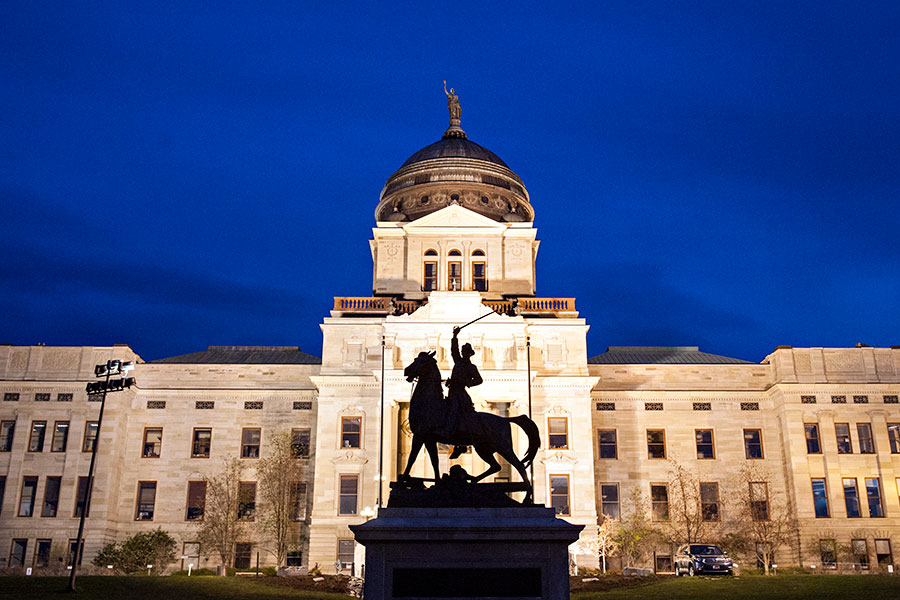Why It Matters
The Legislature is responsible for crafting laws and appropriating money to fund services and programs that widely affect Montanans’ daily lives, and will be tasked this session with deciding major issues such as the future of Medicaid expansion, slated to expire in June. The election gave Democrats a few seats, but the Legislature’s fundamental structure remains unchanged, with Republicans still controlling the House and Senate but Democratic Gov. Steve Bullock wielding the veto pen, setting the stage for negotiating showdowns on a range of important matters. Key votes will once again require give-and-take collaboration.
From a balance-of-power perspective in the state capitol, the midterm election results didn’t really change anything, which is meaningful in its own right.
Democrats picked up two seats in the state Senate and one in the House of Representatives, pending final counts with provisional ballots and one possible recount as of Nov. 12, but Republicans maintain firm majorities in each chamber at 30-20 and 58-42, respectively. The GOP has been in control of both legislative chambers since 2011.
The governor’s office, meanwhile, remains in Democrats’ hands, as it has since 2005, meaning the state has had a split government for over a decade, a departure from the decade-long Republican control of both the Legislature and governor’s office between 1995 and 2004.
What this means is that Republicans will yet again have more influence in dictating the legislative agenda, but Gov. Steve Bullock’s pen will have the last word, contributing to a checks-and-balances system, as the Republicans’ majorities aren’t big enough to achieve a two-thirds vote to override Bullock’s veto without the votes of Democrats.
Much of the upcoming legislative session’s specifics remain unclear as of this writing, with each party’s caucuses set to vote on leadership on Nov. 14, Bullock expected to release his two-year budget later in the week and session committee meetings yet to begin.
But a few realities are clear. One is that Medicaid expansion will again be a foremost priority and hot-button issue, in the wake of Initiative 185 failing. I-185 would have helped pay for continuing Medicaid expansion past 2019 by raising funds through increased taxes on tobacco.
Bullock, among other Democrats, lobbied for the initiative’s passage, but a number of Republicans argued lawmakers are responsible for addressing expansion, as outlined in the 2015 legislation, which included a provision to revisit the issue in 2019.
“The Legislature passed this program on a trial basis with the intention of assessing whether it was effective and if it could be afforded,” Republican Sen. Bob Keenan of Bigfork wrote in an op-ed opposing I-185, adding that the initiative would have “cut the Legislature out of the process, bypassing them and avoiding the examination of Medicaid expansion originally planned.”
So now the Legislature will get its opportunity to examine and tweak — and figure out how to fund — Medicaid expansion, setting up a new round of heated negotiations between Republicans and Democrats, including Bullock and his veto pen. Without legislative action, funding for the expansion will expire in June.
The 2015 Medicaid expansion bill, called the HELP Act and sponsored by Great Falls Republican Sen. Ed Buttrey, passed when a contingent of Republicans joined Democrats in approving the measure at the tail end of a contentious legislative session.
Republicans have already made clear they will bring to the table a number of proposals regarding Medicaid expansion this session, including a work requirement for able-bodied adults and changes to workforce training requirements, among others.
That discussion, and the many others set to take place during the 90-day session, will all be conducted as the Legislature works on its primary responsibility: passing a constitutionally mandated balanced budget.
Following the 2017 session, legislators convened a second time in a special session to address a $227 million budget shortfall, a dire outlook caused by low revenues and an expensive wildfire season, with both Democrats and Republicans blaming the other party for the budgetary crisis.
The shortfall led to sweeping cuts, impacting agencies across the board but especially the Department of Public Health and Human Services. Bullock then announced in July of this year that $45 million of the slashed funding would be restored thanks to higher-than-projected revenues.
While the budgetary outlook appears to be more stable on the eve of this session, Bullock warned prior to the November election that failure to pass I-185 would lead to difficult decisions in the absence of a dedicated funding source for Medicaid expansion.
“If I-185 fails to pass the ballot initiative, we’re going to be in for a tough (2019 legislative) session,” Bullock told the Montana Association of Counties in September, according to Montana Public Radio. “If you thought cuts from last special session were difficult, I think you should brace, unfortunately, for even more.”
As usual, Republicans dominated local legislative races, winning 10 of Flathead County’s 12 state House and Senate races on the midterm ballot. The lone Democratic winners, once again, were incumbent Whitefish Rep. Dave Fern, who handily defeated Libertarian Cindy Dyson, and incumbent Hungry Horse Rep. Zac Perry, who squeaked by Republican Jerry O’Neil.
Sen. Mark Blasdel, a veteran Republican lawmaker from Somers, said legislators are ready to get to work following an election season that saw tens of millions of dollars pour into high-profile federal races and initiatives, leaving legislative candidates struggling to gain a foothold in the public discussion.
“It really sucked the air out of the other races as far as the candidates getting a message through,” Blasdel said. “The voters were so inundated day in and day out. It was hard to gauge if you really were getting to voters and what was the best way to get voters. It was a challenge.”
